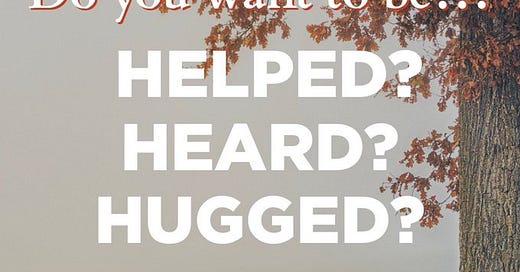Embracing Your Superpower as a Supercommunicator
Nine simple words can transform a conversation.
Do you ever get frustrated in conversations, feeling like no matter how hard you try, you’re just not getting through to the other person? I have often been stymied by the question, “What am I doing wrong here?” when trying to make a point, offer feedback, or request support. This feeling is all too familiar for me as a parent, an educator, a coach, and a spouse.
It turns out that this phenomenon is common for many people. The author Charles Duhigg in his compelling book, Supercommunicators: How to Unlock the Secret Language of Connection, provides a wealth of research and strategies to overcome these barriers. While his book has many great points, I was compelled by this simple question: What kind of conversation are you having? He defines that all conversations are either practical, social, or emotional. So far, so good.
The breakdown comes when we think we’re having one kind of conversation and find out the other person is having a completely different type of conversation. I want to talk with Ken about scheduling the weekend’s activities (practical), but he needs to vent with me about a really tough meeting he had today (emotional). Unless one of us adjusts to match the other, we’re likely to both leave frustrated. Ken may be left feeling that I’m not there for him when he’s down, and I may not have clarity for the logistics of the weekend’s Costco run, tutoring and play dates.
While Duhigg’s model is elegantly simple, his solution is even simpler. Ask the other person:
“Do you need to be helped, heard, or hugged?” Those nine simple words unlock the power to identify the type of conversation we both seek to have, and give us time to adjust.
In a 2023 tweet, journalist Maria Shriver posed this same question and encouraged readers to not simply to reply to her but to tell those they love. That’s where I think the real value of these words will be seen, by offering and asking those with whom we communicate the most. I sometimes see this as helped, heard, or held. But the point is the same. What kind of conversation should we have: practical, social, or emotional?
You can learn more about this principle from Duhigg’s 2024 TEDx Manchester talk, or hearing one of his over 65 podcast appearances last year. (I think his publicist also must be a supercommunicator. I’m impressed with Duhigg’s stamina and reach.) But my favorite treatment of Duhigg’s scholarship is in Tanmay Vora’s visually inspiring blog on The Art of a “Learning Conversation.” Tanmay’s given me permission to share his remarkable visual synthesis of Duhigg’s book for you here:

Check out Vora’s entire body of work. I was blown away by his ability to find the essence of a concept and visually represent it so powerfully. I hope to take one of his workshops someday.
But to really get a keen understanding of Duhigg’s work, just try it. This next week, when you feel like a conversation is going nowhere, stop, ask, and then listen. Does the other person need to be helped, heard, or hugged? Equipped with that knowledge, you can then renew the conversation and match them more effectively. Drop me a note below and let me know how it goes.
Mark your calendar for Sunday afternoon, March 16.
Whether you join us online or in person, I hope you will attend this inspiring event.
Over the next month, I will share more with you about the remarkable women who are coming together for this event, the third such collaboration I’ve been honored to co-produce. I’m just beginning my coaching work with these speakers over the next six weeks. While attending is free, registration is necessary to hold your spot.
Talk of the week: Josh Gad
Recently I devoured the audio version of Josh Gad’s memoir, In Gad We Trust: A Tell-Some. It’s fantastic. While I’ve seen him on Broadway in the Book of Mormon and the 25th Annual Putnam County Spelling Bee, it’s his voicing of the character Olaf in the Frozen films that has delighted both my kids for years. But before all that acclaim, he participated in high school forensics (competitive speech and drama activities). Gad not only competed, but he was the 1998 national champion in the same event that I, too, enjoyed: original oratory. So today I invite you to watch this somewhat fuzzy but incredibly funny YouTube video of his oration: Punchline. (Play through to the very end—you’ll be “gad” you did.)
JD’s Recommendations: what I’m reading, hearing, and viewing:
Reading: Permit me to cheat here, just a bit, and point you to my own writing on the Power of Building Communication Skills in a cohort that I published on LinkedIn.
Hearing: Enjoy passionate founder Blake Benton describe Why simplifying your message and tailoring it to donors is more important than ever on the Million Dollar Nonprofit podcast.
Viewing: enjoy this unreal Subway Symphony Concert. That’s nothing I’ve seen on BART.
Enjoy what I’ve shared here and let me know what you are consuming. I’m choosing to be super intentional in 2025 about what I let in to my mind and body. I treasure hearing what’s delighting you these days.







My husband chuckled when I mentioned the three H’s. He said I definitely liked to be heard. 😂
Great Advice JD.